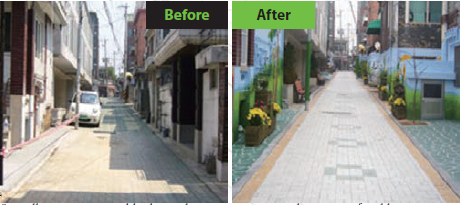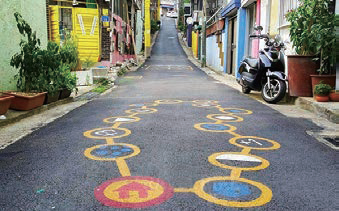Places with dark and narrow alleys on winter nights are especially susceptible to crime. Crime prevention through environmental design (CPTED) is a spatial design technique developed to prevent crime in the aspect of “location,” which is one of the factors of crime occurrence. The beginning of CPTED originated from a case in New York during the 1980s, in which over 60 million felony cases occurred per year, especially in subway stations. New York City started to remove graffiti from the walls of the stations, and cleaned 6,000 trains at the base for five years. Felony and heinous crime rates decreased to 50% in 1994, and finally fell to 25% after such efforts. Although it has not been many years since the acceptance of CPTED in Korea. It has proven that even a little attention towards the environment has a strong power to change society. The Sungkyun Times (SKT) explores how the environmental design can prevent crimes by investigating the concept, principles, and an exemplary case of CPTED.
What is crime prevention through environmental design?
Concept
CPTED is defined as a method that reduces the fear and the range of crime through appropriate design and effective use of architectural environment, according to the National Crime Prevention Institute (NCPI). The ultimate purpose of CPTED is an enhancement of the quality of life, and its analysis mainly focuses on the spatial factors of the causes and precautionary measures of crimes. The National Assembly inspection reported the crime clock, which shows the ratio of crime occurrence to fixed time intervals, in 2013, and it was revealed that five major crimes occurred every 54 seconds. The clock is ticking faster every year, and a new method to exert psychological influences on criminals by proactively changing the environment was required. CPTED, which was newly introduced to meet this need, is effective in dealing with places susceptible to violent crimes, including deserted houses, unfrequented alleys, unused resting places, and streets with no light posts. A database of crime hot-spots is stored with geographic information system (GIS) and turned into a density map. The location, distance, and direction of the offender and the victim are shown on the map, and crime occurrence density appears differently for each crime.
Relevant Theories
CPTED is based on environmental criminology, which emphasizes the role of space among the four factors of crime occurrence: law, victim, offender, and location. It analyzes criminal patterns within speci_c environments, considering the fact that criminals take the chance of crime in particular settings. Criminals _nd an opportunity when there are a motivation, an attractive target, and an appropriate environment, while capable guardianship is absent. It can also be explained by the rational choice theory in that criminals decide to commit a crime after the consideration of settings. For instance, in places where the patrol is reinforced with high risk of detection, they would decide not to commit the crime. Theories relevant to the purpose of CPTED are situational crime prevention theory and defensible space theory. They pursue a systematic design and management of the environment, and CPTED aims to create a defensible space, which is defined by territoriality, surveillance, expression of local image, and adjacency to safe places. Its primary goal is crime prevention, and further goals are fear reduction and activation of local communities.
Change in Paradigm
The first generation of CPTED focused on the change of physical environments, especially in residential areas. The main agents of implementation were the country, executive agencies, and experts, and some limitations were the narrow applicable range and its inability to solve the balloon effect. The current trend of CPTED was developed to complement these limits and analyze more fundamental problems. It focuses not only on physical settings, but also on socio-cultural factors like the participation of residents. It emphasizes the cooperation between experts and citizens by facilitating the cultural exchange between neighborhoods, and broadens the range of environmental designs starting from residential areas to school facilities or streets.
Principles
CPTED Research Information Center defines the basic factors for establishing requisite of CPTED and principles for real life application as below.
Three Basic Factors
| Surveillance | Access Control | Community Building |
| Mechanic: lighting, Closed-Circuit Televisions (CCTV) | Mechanic: locking device, safety equipment | Citizen participation |
| Systematic: police, guard | Systematic: police, guard | Informal social control: community pressure |
| Natural: window, spatial design | Natural: entrance, border line of lot | Voluntary management of environment |
Six Principles for Application
Surveillance
Surveillance can be divided into mechanic, systematic, and natural surveillance. Natural surveillance is a new form of surveillance in CPTED that prevents crime through space arrangement and facility design. It places potential offenders and victims within the connected line of sight by minimizing blind spots and securing a forward view of width space. Surveillance includes getting rid of obstacles, tearing down walls, and securing open structures.

• Access Control
Access control is a space arrangement meant to induce certain behavioral patterns in potential offenders. It limits paths and minimizes escape routes of criminals. It has an advantage in that it lessens the closed image of artificial facilities. Access control also includes designing a facility by eliminating spaces to hide in or installing security grilles and gas pipeline covers to prevent trespassers through abnormal access routes. One type of space arrangement is the cul-de-sac, which means dead-end street. It is often circular to exclude the traffic passing through the area and to control the entrance of outsiders, blocking the retreat route of offenders.

• Territorial Reinforcement
Territorial reinforcement is making the physical or psychological boundary stand out to trigger the responsibility towards specific objects or areas. Territory is divided into public, semi-public or semi-private, and private spaces. An area setting can be specified by clarifying the management domain for each household and separating roads, flower beds, and pedestrian paths thoroughly. It facilitates crime detection and increases the psychological burden on potential offenders, working as a direct or an indirect control over antisocial behaviors.
• Activity Support
Activity support encourages the residential use of local facilities or spaces, and aims to eliminate blind spots and enhance the efficacy of surveillance through the “eyes on the street.” It renovates neglected places into resting places with sports equipments to meet the needs and wants of local citizens. • Legibility Legibility in CPTED facilitates the recognition of the space and facilities. It simplifies the structure of streets to aid in finding pedestrian paths. Legibility refers to the effectiveness of distinguishing information or security facilities, which can be enhanced by differentiating the color of lamp posts attached to emergency alarms and putting an identification number on telephone poles.
• Maintenance and Management
Maintenance and management emphasizes the participation of residents and continuous attention on the environment. It is based on the broken windows theory, in which a building with broken windows might cause people to break a few more windows since they become desensitized to the negative impacts of vandalism, thus showing an absence of social order and triggering the proliferation of further crimes. CPTED, therefore, emphasizes the importance of consistent concern on the environment not to make criminals recognize the insufficiency of risk management as a chance for a crime.
Successful Case and Implications
Exemplary Case
A successful case of CPTED is the Salt Street of Yeomni-dong, Mapo-gu, Seoul. The name “Salt Street” derived from its local specialty, as it was once an area where workers delivered salt from the boats on the Han River to the salt warehouses. The Salt Street was a crime-ridden district of Seoul, full of narrow alleys, unmanaged housings, and nasty surroundings. It was then assigned as a district for CPTED in 2012, and became an exemplary case of CPTED in Korea. CPTED in the Salt Street applied the same principles introduced above. For surveillance and access control, street lights and surveillance cameras were installed on each street, and the uniqueness of the Salt Street can be seen through six yellow door houses. Yellow door houses were made to perform the role of a police substation in neighborhoods. Doors are open all day long, and not only are CCTVs installed, but emergency alarms and LED lights are also attached on the walls. In the aspect of activity support, old and dark streets were renovated into resting places for local citizens and tourists. 1.7 km of criminal hot-spots perfectly changed into walking courses, and bodybuilding manuals or stretching posts were attached to 69 street lights. The Salt Street also applied the principle of legibility. To enhance the effectiveness on the recognition of security facilities, LED number signs were put on each street light. LED number signs function by detecting the locations of pedestrians through coordinates, and the police move to the coordinates of telephone poles based on the information taken from surveillance cameras. Lastly, for maintenance and management, residents of the Salt Street are actively involved in the CPTED project. Drawings on the stairs and walls were all created by the cooperation of the government and citizens, and were left clean and intact thanks to the persistent attention of the neighborhood. The ef_cacy of the CPTED project in the Salt Street was shown in a survey conducted in 2013, where the recognition rate of the citizens on the effectiveness of crime prevention increased to 78.6%, and satisfactions of citizens reached 83.3%.

Implications

• Regional Relevance
Environmental designs like murals and wall paintings renovate outdated places and improve local image. Meaningless designs that do not reflect local identity, however, can have adverse effects. The most important factor of CPTED is the participation of the residents, and the regional relevance of the design has a strong power to encourage local attention. Without consistent maintenance and management of the environment, the broken windows theory would be realized, and the vicious cycle of environmental negligence would continue.
• Design Effectiveness
CPTED also considers its effectiveness. In case of lightings, they should be installed at regular intervals with a consistent intensity, and the colors or shapes of objects should be clearly distinguishable under the lights. For instance, CPTED Research Information Center announced that dim lightings installed sparsely are more effective than bright lightings installed closely, and an unfamiliar color of lightings, like red, can increase psychological burden while also obscuring the visibility. Although Japan once lowered crime rates by changing red lights to blue (based on an experiment claiming the calming effects of blue colors), careful consideration when using unfamiliar colors is necessary. The current trend of street lightings is using white LED lightings, while minimizing the light pollution.
• Resident Convenience
The main purpose of CPTED is improving the quality of life. CPTED must provide convenience to residents and be closely related to the lives of people. Current CPTED, however, is sometimes criticized for its concentration on aesthetic aspects. A similar problem can be seen in the case of the Salt Street: although it became a well-known tourist attraction, residents are gradually leaving their homes because of urbanization and the inconveniences of living in an isolated village. CPTED is truly helpful only when it is user friendly.
• Fallacy of Generalization
CPTED was introduced to eliminate crime-inducing opportunities by exerting mental pressure on potential offenders, and is optimized for preventing premeditated crimes. This means that CPTED is not an all-purpose solution for all patterns of crime, and it could be ineffective in an opportunist crime. It is important not to commit the fallacy of generalization when analyzing different types of crime.
Efforts to guarantee the safety of citizens are gaining more attention and becoming more diversi_ed. CPTED is a new paradigm of crime prevention and can be seen in various daily environments. For instance, Seoul City is now providing safe locker services for women who live alone, where lockers are installed in public places near their houses to prevent a robbery in residential areas. Considering that facility designs and space arrangement techniques are developing continuously, the future progresses of CPTED are expected to be bright.
